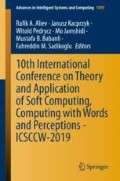Abstract
One of the factors that play an important role in the formation of an effective tax system is to increase the effectiveness of tax administration. This research is implemented on the assessment of tax “tax collection per a tax employee”, which is one of the characterized indicators of the administration efficiency. Evaluation is investigated as a multi-criteria decision-making problem using Delphi query method. As the survey results consist of both quantitative as well as qualitative indicators, this evaluation is conducted by 2 methods that have computing opportunity by taking into consideration these indicators: The weighted sum model and Brown-Gibson model.
Access this chapter
Tax calculation will be finalised at checkout
Purchases are for personal use only
References
Tanzi, V.: The IMF and tax reform. IMF Working Paper 90/39 (2004)
Gill, J.: A diagnostic framework for revenue administration. The Tax Policy and Administration Thematic Group. The World Bank technical paper 472 (2000)
Stallmann, J. I.: Evaluating tax systems. Missouri Legislative Academy (2004)
Juozaitienė, L.: Comparison of Lithuanian and Irish tax systems using V. Tanzi qualification diagnostic indicators. Ekonomika ir vadyba: aktualijos ir perspektyvos 2(15), 65–75 (2009)
Skackauskiene, I.: Tax system evaluation model. In: 6th International Scientific Conference Vilnius, Lithuania, Business and Management, Selected Papers, Vilnius, pp. 719–727 (2010)
Jakštonytė, G., Giriūnas, L.: Tax system efficiency evaluation modeling with reference to V. Tanzi criteria. Economics and management (2010)
Kumar, S., Nagar, A.L., Samanta, S.: Indexing the effectiveness of tax administration. Econ. Polit. Wkly. 42(50), 104–110 (2007)
Das-Gubta, A., Estrada, G.B., Park, D.: Measuring tax administration effectiveness and its impact on tax revenue. Working Papers DP-2016–17. Economic Research Institute for ASEAN and East Asia (ERIA) (2016)
Musayev, A.F., Madatova, Sh.G., Rustamov, S.S.: Evolution of the impact of the tax legislation reforms on the tax potential by fuzzy inference method. In: 12th International Conference on Application of Fuzzy Systems and Soft Computing (ICAFS), pp. 507–514. Elsevier, Vienna (2016)
Musayev, A.F., Madatova, Sh.G., Rustamov, S.S.: Mamdani-type fuzzy inference system for evaluation of tax potential. In: Sixth World Conference on Computing dedicated to 50th Anniversary of Fuzzy Logic and Applications and 95th Birthday Anniversary of Lotfi A. Zadeh, Berkley, USA (2016)
Rustamov, S.S., Musayev, A.F., Madatova, Sh.G.: Evaluation of the Impact of state’s administrative efforts on tax potential using Sugeno-Type fuzzy inference method. In: ICAFS 2018, Advances in Intelligent Systems and Computing, vol. 896, pp. 352–361 (2019)
Crandall, W.: Revenue Administration: Performance Measurement in Tax Administration. Technical Notes and Manuals 10/11 (2010)
Musayev, A.F., Guliyev, H.H., Efendiyev, G.M., Gazanfarli, M.Kh.: Evaluation of the staff’s professionalism level by modified weighted sum model. In: Tenth World Conference “Intelligence Systems for Industrial Automation”, WCIS-2018, Tashkent, Uzbekistan (2018)
Zadeh, L.A.: Fuzzy sets. Inf. Control. 8, 338–353 (1965)
Triantaphyllou, E.: Multi-criteria decision making methods. A Comparative Study (2000)
Fishburn, P.C.: Additive Utilities with Incomplete Product Set: Applications to Priorities and Assignments. Operations Research Society of America (ORSA), Baltimore, MD, USA (1967)
Mamdani, E.H., Assilian, S.: An experiment in linguistic synthesis with a fuzzy logic controller. Int. J. Man-Mach. Stud. 7(1), 1–13 (1975)
Author information
Authors and Affiliations
Corresponding author
Editor information
Editors and Affiliations
Rights and permissions
Copyright information
© 2020 Springer Nature Switzerland AG
About this paper
Cite this paper
Musayev, A.F., Aliyev, A.G., Musayeva, A.A., Gazanfarli, M.K. (2020). Evaluation of Tax Administration Effectiveness Using Brown-Gibson Model. In: Aliev, R., Kacprzyk, J., Pedrycz, W., Jamshidi, M., Babanli, M., Sadikoglu, F. (eds) 10th International Conference on Theory and Application of Soft Computing, Computing with Words and Perceptions - ICSCCW-2019. ICSCCW 2019. Advances in Intelligent Systems and Computing, vol 1095. Springer, Cham. https://doi.org/10.1007/978-3-030-35249-3_28
Download citation
DOI: https://doi.org/10.1007/978-3-030-35249-3_28
Published:
Publisher Name: Springer, Cham
Print ISBN: 978-3-030-35248-6
Online ISBN: 978-3-030-35249-3
eBook Packages: Intelligent Technologies and RoboticsIntelligent Technologies and Robotics (R0)

